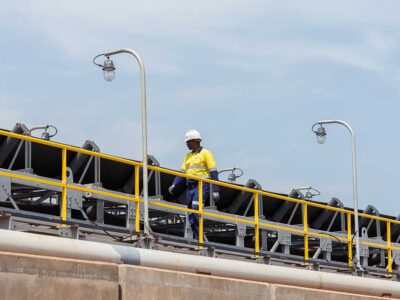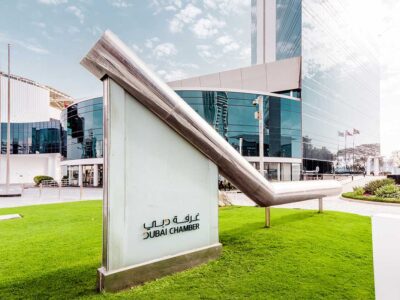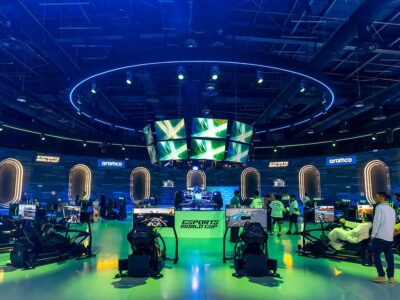Al Sumaria, an Iraqi variety entertainment channel, backed by Lebanese investors, may have several stories to tell its viewers every day. But there’s one that it hasn’t told anyone – its own story of how it shifted to a new production and playout facility in Lebanon in just one afternoon.
The first Iraqi channel to be launched after the fall of Saddam Hussein, Al Sumaria wanted to build its headquarters in Lebanon, far from the war and destruction in Baghdad. What it didn’t bargain for was a similar situation in Lebanon in the summer of 2006.
The channel, which already had a production facility and over 300 staff in Iraq, began its Beirut operations in 2004 from a temporary facility while a state-of-the-art production, and newsroom and playout facility was being designed in a new location in Lebanon. The US $3 million project was awarded to Lebanese systems integrator, Broadcast & Communication Systems (BCS), and the final phase of the project was scheduled for completion in 2006.
However, in July 2006, when the war between Lebanon and Israel began, Al Sumaria found itself stuck in a war zone. One day, it was decided that the channel would move its 200 odd staff and equipment immediately to the new premises. What should have been a four-month shift, therefore, happened one afternoon, and Al Sumaria moved to a brand new facility in the summer of 2006.
“We initially built the newsroom system at the ART facility,” says Joseph Hallage, sales & marketing manager of BCS. “At that time, the rest of the equipment was being flown in. We were supposed to start shifting slowly and part by part a couple of months from then. But with the war, we found ourselves in a situation where we had to move everything to the new facility or suffer damage. And then, they had to be back on air within 48 hours. This was a major challenge. What should have been a three-month move got done in 48 hours. It was a huge challenge during such difficult times but then, a war can make you do things you cannot bring yourself to do under normal circumstances,” he adds.
The quick move, however, hasn’t stopped Al Sumaria from being one of the top facilities in the Middle East today. The TV station boasts a digital newsroom – the first of its kind in the Middle East. It has put in place a tapeless integrated newsroom that the BBC World Service has now adopted for its new Arabic TV channel. Al Sumaria combines standard IT infrastructure (servers, storage, workstations) with proprietary broadcast equipment (Omneon server, Autoscript teleprompter). In doing this, it has invested in a cost efficient and easy-to-maintain system that most broadcasters today are still striving to put in place in the near future. Al Sumaria’s newsroom application uses a Dalet newsroom system along with an Omneon server and Net Apps storage. Its automation system includes a playout system that runs on Harris automation along with a Seachange server.
Although the new servers are competitive products, Jad Faddoul, deputy IT manager of Al Sumaria says, the channel chose Omneon with Dalet and Seachange with Harris because it felt those systems worked best in combination with each other. “Dalet and Omneon work well and Harris and Seachange are great together,” he explains.
Al Sumaria uses a DaletPlus News Suite, which provides it with a single platform that acts as newsroom computer system, a news production system as well as an automation and archiving platform. The journalists at Al Sumaria use DaletPlus News Suite workstations to browse video feeds from News agencies straight from their desktops. Agency feeds are captured by DaletPlus Ingest for firewire loop recorders which run on standard IT servers. These, in turn, are connected to professional FireWire bridges to continuously record incoming feeds in a buffer. Crash and scheduled recordings extract the video from these buffers to store the recorded material onto a central production storage, which in this case, is a NetApp network attached storage system). Journalists then make shot selections on the fly using Dalet MediaLogger and share these with editors that put together simple packages using Dalet MediaCutter.
At the TV station, packages are finalised by editors who use Adobe Premiere Pro workstations and then save the final package back to the networked production storage. All media is stored centrally in native DV 25 and accessed across a Gigabit Ethernet network. In addition to production and play-out, DaletPlus News Suite is used by journalists and producers to browse incoming wire feeds, write scripts and build rundowns. Field reporters remotely contribute to the newsroom using their web-browser. Finalised stories that are scheduled for broadcast are then automatically migrated by DaletPlus News Suite from the production storage to the Omneon Spectrum Media server. Play-out and show-time tracking is ensured in the gallery using DaletPlus News Suite workstations that drive the teleprompter and the Omneon server.
“One reason why this newsroom is unique is because the DaletPlus News Suite system used at Al Sumaria greatly simplifies the complexity of the newsroom environment,” explains Nicolas Hans, director of marketing, Dalet. “At Al Sumaria, the newsroom workflow is 99% file-based. Video signals come in and video play-out is the final result. Once video is ingest, IP packets replace video streams. Logging, editing, transfers and all other operations are done on files. Not only does this allow for faster than real-time operations which facilitates breaking news coverage, it also means that there is less video cabling, less video specific infrastructure. This gives way to significant cost-savings in terms of deployment. At Al Sumaria, the Ethernet computer network is the backbone for production – not the SDI routing,” he adds.
For a Middle East-based channel, Al Sumaria has thought progressively and made itself future proof. It has, for instance, chosen to use standard IT infrastructure. “Many newsroom systems rely on proprietary, broadcast specific systems. Each system has its own specifics, which generate increased costs: each system requires specific spare parts, tailored service contracts, specially trained engineers. At Al Sumaria, the infrastructure is simplified because it first and foremost relies on standard computer servers, storage and network,” explains Hans.
Computer-based newsrooms designed in the last five years typically involve a large number of distinct systems: a newsroom computer system that manages scripts and rundowns; a news production system which provides video production tools; an automation system for controlling ingest and play-out; an archive system to track the metadata of tape-based archives.
At this channel, there is one system that runs on standard IT and drives the end-to-end workflow: from the ingest of video feeds on standard computers connected to broadcast quality FireWire bridges, to the Omneon-based playout and on-line archiving. As a result, there are fewer broadcast specific systems to integrate. The digital newsroom still needs to talk to the Omneon video server, the computer graphics engine and the router. But overall, it’s a much simpler system.
Technically, this simplification is made possible by the recent evolution in computer technology. Until recently, collaborative video editing required the systematic use of proxy video. In parallel to the ingest of broadcast quality video, a low bit rate version or proxy was generated; that proxy was the only version available from the desktop. Image quality was limited but, more importantly, the infrastructure required to generate the proxy in a frame-accurate fashion and to keep it synchronised with broadcast video could only be afforded for large installations. Today, a system like the one deployed at Al Sumaria runs broadcast quality video all the way to the desktop. Proxies are only generated for remote browsing and archived material.
“The impact of this simplicity on the cost of news production is tremendous,” says Hans. “For one, the cost of acquisition is radically changed. Where it used to require a minimum investment of US $10 million to launch a newsroom, you can today have a proper digital newsroom for less than $1 million. Secondly, the cost of ownership is lower because instead of using proprietary equipment, broadcasters can leverage best-of-breed computer technology and the skills that go with it. This is especially important in the Middle East, where broadcast companies cannot always provide local support because the market size does not justify it. Finally, simplicity means increased flexibility, which can empower journalists to cover the news as they want it,” he adds.
Computer technology keeps evolving. Moore’s law dictates that every 18 months, we have twice as much computing power for the same dollar. But as the technology keeps offering more and more computing, networking and storage power, it can address new markets.
Hans likes this evolution to a digital wave. “As it moves, it hits new beaches,” he says. Twenty years ago, when the first Mac computer was introduced, the publishing business was drastically reinvented. Adobe Indesign, Quark, digital cameras and direct to plate printing technology allow us to make magazines easily today. Ten years ago, the radio business underwent a change. Tapes were replaced with files and DJs were freed from CDs. Instead of spinning disks, they began to do it with the touch of a button. Today, it’s the turn of the TV.
These last 18 months, computer technology has brought major breakthroughs for the broadcast business. Since last March, disk storage is cheaper than tape. This allows for new ENG technology such as Panasonic P2 and Sony XDCAM to become truly competitive. In terms of processing, Intel Core Duo and AMD quad-core processors make it possible to edit HD video on an off-the-shelf PC. Finally, bandwidth is booming. Gigabit Ethernet is no luxury anymore and ADSL connections have dropped in cost worldwide. The technology is now mature to radically change the way we do TV.
In the newsroom, this means that complex things can become simpler. We can finally replace analogue workflows with new digital ones. “Today, newsrooms like Al Sumaria are examples of how scripts, rundowns, feeds, and clips are all files. They’re not special, proprietary files. They’re just files. They’re still complex files but standards such as MXF and XML are being put in place so that broadcasters can take these files and use them anywhere on any system,” explains Hans.







